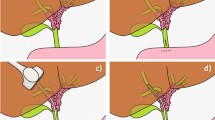Abstract
Copious persistent postcholecystectomy biliary fistula may result from severing a large unrecognized aberrant duct from the right lobe of the liver that empties into the gallbladder or cystic duct. Recognition of aberrant biliary ducts and identification of the major intrahepatic biliary radicles on cholangiography are emphasized. Two cases are presented. In 1 case percutaneous transhepatic cholangiography (PTC) made the diagnosis. PTC is a safe, accurate method for evaluating postcholecystectomy biliary fistula.
Similar content being viewed by others
References
Glenn F:Atlas of Biliary Tract Surgery. New York: MacMillan Company, 1963, p 138
Foster JH, Wayson EE: Surgical significance of aberrant bile ducts.Am J Surg 104:14–19, 1962
Hatfield PM, Wise RE: Anatomic variation in the gallbladder and bile ducts.Semin Roentgenol 11:157–164, 1976
Hayes MA, Goldenberg IS, Bishop CC: The developmental basis for bile duct anomalies.Surg Gynecol Obstet 107:447–456, 1958
Healy JE, Schroy PC: Anatomy of the biliary ducts within the human liver: analysis of the prevailing pattern of branchings and the major variations of the biliary ducts.Arch Surg 66:599–616, 1953
Schoenfield LJ:Diseases of the Gallbladder and Biliary System. New York: Wiley, 1977, pp 256–257
Seldinger SI: Percutaneous transhepatic cholangiography.Acta Radiol [Suppl] (Stockh) 253:10–11, 1966
Netter FH:The Digestive Tract, Vol 3 The Ciba Collection of Medical Illustrations, Summit NJ: Ciba, 1953, p 23
Manuck L, Amberg J: The bile ducts.Radiol Clin North Am 14:499–525, 1976
Ariyama J, Shirakabe H, Ohasi K, Roberts, GM: Experience with percutaneous transhepatic cholangiography using the Japanese needle.Gastrointest Radiol 2:359–365, 1978
Gold RP, Casarella WJ, Stern G, Seaman WB: Transhepatic cholangiography: the radiological method of choice in suspected obstructive jaundice.Radiology 133:39–44, 1979
Pereiras RU Jr, Chiprut RO, Greenwald RA: Percutaneous transhepatic cholangiography with the “skinny” needle. A rapid, simple and accurate method in the diagnosis of cholestasis.Ann Intern Med 86:562–568, 1977
Weissmann HS, Chun KJ, Frank M, Koenigsberg M, Milstein DM, Freeman LM: Demonstration of traumatic bile leak with cholescintigraphy and ultrasonography.AJR 133:843–847, 1979
Author information
Authors and Affiliations
Rights and permissions
About this article
Cite this article
Rappoport, A.S., Diamond, A.B. Cholangiographic demonstration of postoperative bile leakage from aberrant biliary ducts. Gastrointest Radiol 6, 273–276 (1981). https://doi.org/10.1007/BF01890265
Received:
Accepted:
Issue Date:
DOI: https://doi.org/10.1007/BF01890265




